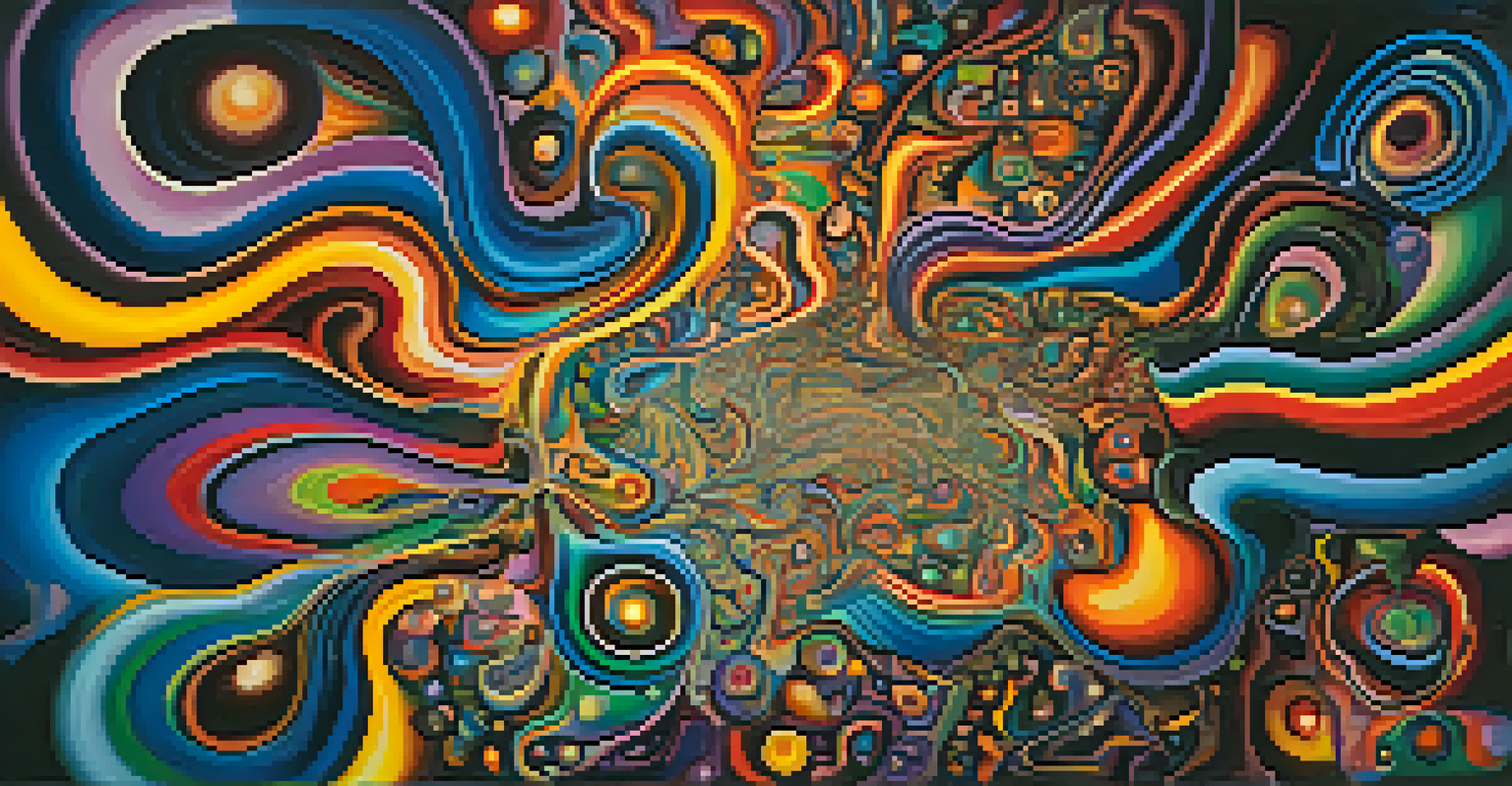The Science Behind Time Perception Alterations with Ayahuasca

What is Ayahuasca and Its Cultural Significance?
Ayahuasca is a traditional Amazonian brew made from the Banisteriopsis caapi vine and other plants. It has been used for centuries by indigenous cultures for spiritual and medicinal purposes. The brew is known for its psychoactive properties, primarily due to the compound DMT (dimethyltryptamine), which can lead to profound altered states of consciousness.
Ayahuasca is not just a substance; it’s a tool for transformation, revealing the interconnectedness of time and consciousness.
In these cultural contexts, ayahuasca ceremonies are viewed as sacred rituals that facilitate healing, self-discovery, and connection to the spiritual realm. Participants often describe their experiences as transformative, with many reporting insights into their lives and relationships. This deep-rooted significance sets the stage for understanding how ayahuasca affects our perception of time.
As we delve into the science behind these experiences, it’s essential to recognize that the effects of ayahuasca are not merely personal or anecdotal; they are deeply intertwined with the cultural and therapeutic frameworks surrounding its use.
Understanding Time Perception: A Brief Overview
Time perception is our subjective experience of time, which can vary significantly based on various factors, such as emotions, environment, and mental states. While we often think of time as a constant flow, research suggests it can stretch or compress in response to different stimuli. For instance, moments of deep joy or fear may feel longer, while monotonous tasks can make time seem to drag.

This variability in how we perceive time raises intriguing questions about consciousness and reality. Scientists have studied these phenomena, often referencing concepts like temporal distortion, where the brain's processing of time can be altered by external influences. This brings us to how substances like ayahuasca might impact our brain's perception of time.
Ayahuasca's Cultural Roots
Ayahuasca is a sacred brew used by indigenous cultures for spiritual healing and self-discovery.
Understanding time perception provides a foundation for exploring how ayahuasca can modify this experience, leading to unique insights and reflections during its use.
The Role of DMT in Time Alteration
DMT, the key psychoactive component in ayahuasca, is known for its intense and vivid hallucinogenic effects. When ingested, DMT interacts with serotonin receptors in the brain, particularly the 5-HT2A receptor, which plays a crucial role in mood, cognition, and sensory perception. This interaction can lead to profound shifts in awareness, including how time is perceived.
In the depths of our consciousness, time becomes fluid, revealing that our past, present, and future are intertwined.
Many users report that during their ayahuasca experiences, time can feel suspended or elongated. For example, a 30-minute journey may feel like several hours, allowing for deep introspection and exploration of thoughts and feelings. This alteration may stem from the brain's enhanced connectivity during the experience, leading to a more fluid and expansive sense of time.
Thus, DMT not only induces vivid experiences but also reshapes how we experience the passage of time, making moments feel richer and more meaningful.
Neuroscience Insights: Brain Activity During Ayahuasca Use
Recent studies using neuroimaging techniques, such as fMRI and EEG, have shed light on how ayahuasca affects brain activity. These studies show that ayahuasca can increase connectivity between different brain regions, leading to a more integrated and holistic experience. This heightened connectivity is believed to contribute to the altered perception of time.
For instance, regions of the brain responsible for processing sensory information, emotions, and memory may become more synchronized during an ayahuasca experience. This synchronization can create a sense of timelessness or a feeling of being present in the moment, which many users describe as enlightening or liberating.
DMT's Impact on Time Perception
The psychoactive compound DMT in ayahuasca alters brain connectivity, leading to unique experiences of time.
Understanding these neural mechanisms helps illustrate how ayahuasca’s effects extend beyond mere hallucinations, offering a profound transformation in how we perceive and relate to time.
Emotional States and Their Influence on Time Perception
Emotions play a significant role in shaping our experience of time, and ayahuasca often brings intense emotional states to the surface. Users frequently report feeling a wide range of emotions, from joy to sorrow, which can influence their perception of time during the experience. For example, moments of profound connection or introspection may feel timeless, while periods of distress could feel like an eternity.
This emotional depth may enhance the insights gained during ayahuasca sessions, as users confront their feelings in a way that can lead to healing and understanding. When emotions are heightened, the brain processes experiences differently, which can stretch or compress time in ways that feel significant to the individual.
Thus, the interplay between emotions and time perception during ayahuasca experiences highlights the intricate connection between our feelings and our understanding of time.
Cultural Narratives: How Stories Shape Time Perception
Cultural narratives surrounding ayahuasca also play a role in how individuals perceive time during their experiences. Many indigenous cultures emphasize the importance of storytelling as a means to convey wisdom and understanding. When participating in ayahuasca ceremonies, these narratives can frame the experience, influencing how time is interpreted.
For example, participants might feel that time is cyclical, reflecting the belief that past, present, and future are interconnected. This perspective can create a sense of timelessness, where individuals feel they are accessing wisdom from different points in their lives. Such narratives can deepen the experience, allowing for profound realizations that transcend ordinary time perception.
Emotions Shape Time Experiences
Intense emotional states during ayahuasca sessions can significantly influence how time is perceived.
By recognizing the influence of cultural narratives, we can appreciate how they shape the ways in which individuals approach and understand their experiences with ayahuasca and time.
Conclusion: The Transformative Power of Time Perception with Ayahuasca
In conclusion, the way ayahuasca alters time perception is a fascinating interplay between neuroscience, emotions, and cultural narratives. Through the psychoactive effects of DMT and the resulting changes in brain connectivity, users often find themselves in altered states where time feels expansive or suspended. This can lead to significant insights and a deeper understanding of oneself and the universe.
The emotional richness that emerges during these experiences further enhances the perception of time, allowing for transformative moments of clarity and connection. As we continue to explore the science behind ayahuasca, we uncover not only its impact on time perception but also its potential to facilitate healing and personal growth.

Ultimately, ayahuasca serves as a powerful tool for those seeking deeper understanding, reminding us that our perception of time can be as fluid and dynamic as our own consciousness.